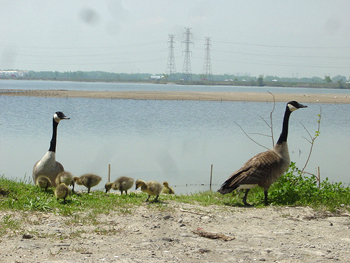Editors note: Congress may invest $475 million this year in Great Lakes cleanup. This story is part of an occasional look at proposals for spending it. Weigh in on this and other ideas on Echo’s Great Lakes Restoration Initiative forum. Other stories.

Indiana's Wolf Lake, degraded by development, has seen restoration work by the Army Corps of Engineers. Photo: I Bird 2, via Flickr
By Jeff Gillies
jeffgillies@gmail.com
Great Lakes Echo
July 23, 2009
A federal agency better known for dredging harbors than building wetlands could soon have a bigger stake in restoring Great Lakes habitats.
For anyone who finds that troubling, Milan Kruszynski has a beach crawling with baby box turtles and 9-inch bull frogs he’d like to show you.
The city of Hammond, Ind., partnered with the Army Corps of Engineers to restore Wolf Lake in 2007. The $7 million project just south of Lake Michigan addressed environmental damage from years of pollution and development.
The Corps dug holes for fish habitat in the lake bottom, built islands planted with native bull rushes and restored 5,000 feet of shoreline. Now the beach is home to box turtles that Kruszinski, director of the Hammond Port Authority, said were once rare.
“But they’re just out now in the open running around because there’s a habitat for them on a sandy shoreline,” he said. “We haven’t had a sandy shoreline in a long time.”
Projects like the Wolf Lake restoration could be popping up more often around the Great Lakes basin. Congress is considering a $475 million appropriation for Great Lakes restoration, and $16 million of that could go to the Corps to restore coastal wetlands, aquatic habitats and fish passage.
One reason for the Corps’ reputation as a dredging and damming outfit is that the agency hasn’t been reconstructing habitats for very long, said Jan Miller, an environmental engineer in the Corps’ Great Lakes and Ohio River Division. The laws that give the Corps the authority for such projects have been around only for 10 to 20 years.
“I’ll be honest, we haven’t built all that many,” Miller said. “I can only point, in the Great Lakes area, probably to 5 or 6 projects that we have built.”
And despite the Corps’ success with Wolf Lake, the agency has a history of causing more environmental damage than improvement, said George Sorvalis, manager of National Wildlife Federation’s water resources campaigns. He also coordinates the Corps Reform Network, a group that advocates against economically and environmentally unsound Corps projects.
Decades of Corps construction along the Mississippi River have hampered the river’s role in building the wetlands that stabilize the Louisiana coast, Sorvalis said. Now the shore is prone to erosion and New Orleans is sinking.
“Upriver dams for flood control and levies on the river for navigation have reduced the Mississippi’s ability to bring sediment into the coastal wetlands,” Sorvalis said. “It’s not natural.”
The agency’s project planning guidelines historically emphasized economic development over environmental sustainability. That meant water problems were given short-term solutions that tried to control and contain rivers with structures, Sorvalis said.
“Projects that work with nature — land use planning or allowing rivers to overflow into flood plains — often get overlooked,” Sorvalis said.
In 2007, Congress instructed the Corps to give environmental protection more weight. The White House recently took over that initiative, saying the new rules could apply to all federal agencies developing water projects.
Though Congress greened the Corps’ mandate, the lawmakers are also to blame for destructive water projects, Sorvalis said. Congress chooses which projects get funded, a process vulnerable to political favoritism.
But the Corps’ slice of the $475 million Great Lakes Restoration Initiative should come with fewer strings attached, Miller said. The Environmental Protection Agency is working to keep the appropriation earmark-free.
“And so far, so good,” Miller said. “That way the projects can be ranked on their own merit.”
The restoration initiative will fund a backlog of Corps projects, Miller said. Some of those are ready for construction, while others still need planning and design. The agency will also solicit new projects from states and environmental groups.
The Corps can do good restoration work when it has a good plan, funding and the right partners, Sorvalis said.
The initiative, which incorporates 16 federal agencies, will give the Corps funding and partners. But any entity that gets $16 million for a job this big still needs public involvement and oversight, he said.
“I’m hopeful, but not enough to turn my back on anything.”
Is this a good use of the $475 million Congress may spend on Great Lakes restoration? Let us know on Echo’s Great Lakes Restoration Initiative forum.
Yes, it is of course the right step by the U.S army.
An engineer’s role in solving the global issues addressed is to extend engineering designs according to available global resources, make designs socially and economically feasible and design for a sustainable future. An engineer holds a remarkable responsibility toward the world’s present as well as the future well being. Therefore, some of the recommendations to future engineers and higher education institutes are educating new engineers in the fields of renewable energy sources and their applications, encouraging research and funding in to fields that are crucial to the global economy, society and the environment at present.
Intersting link on the role of Engineer:
link: http://en.oboulo.com/role-of-an-engineer-in-solving-global-issues-63960.html
Proud to be an Engineer
This is too great a leap of faith with precious dollars. Instead, funding should be taken away from the Corps for environmentally damaging projects in the Great Lakes region that are on the books and drawing boards.